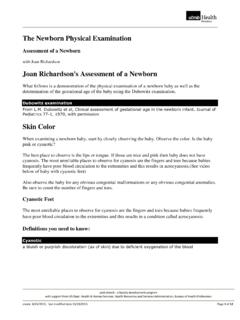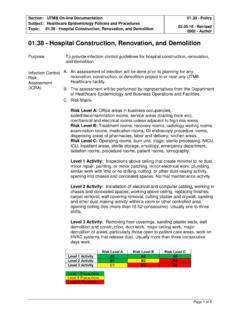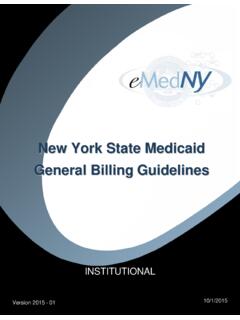Transcription of Institutional Handbook of Operating Procedures Policy 09 ...
1 Institutional Handbook of Operating Procedures Policy Section: Clinical Policies Responsible Vice President: Executive Vice President utmb Health System Subject: General Responsible Entity: Quality Management I. Title Suicide Risk Screening and Suicide Precautions for Patients II. Policy The University of Texas Medical Branch ( utmb ) Health System is committed to providing a safe environment for patients, students, visitors, and employees. Identification of individuals at risk for suicide while under our care and following discharge is an important step in protecting those individuals at risk.
2 Determining Need for and Conducting Suicide Risk Screening: Clinical staff who perform intake screening on patients 12 years old or older, within the utmb Health System, will document whether or not a patient is being evaluated or treated for a behavioral health condition as their primary reason for care. Additionally, clinical staff will document if they become concerned by emotional or behavioral disturbances exhibited by any patient at any time during the patient s clinic visit/admission, regardless of the primary reason for care. Screening for Suicidal Ideation: Patients determined to have a behavioral health condition as their primary reason for care or who exhibit emotional or behavioral disturbances will be screened for suicidal ideation by utilizing a validated screening tool and the provider will be notified of positive results.
3 If the screening result is positive, suicide precautions will be implemented. (See Appendix 1: PHQ-9). Suicide Risk Assessment/Reassessment: A suicide risk assessment will be conducted by a provider on any patient who screened positive for suicidal ideation using an evidenced-based risk assessment tool. Interventions for the safety of the patient will be implemented based on the risk level determined by the provider and the patient s risk assessment. (See Appendix 2: SAFE-T Protocol with C-SSRS). A reassessment will be conducted by the provider using an evidenced-based risk assessment tool, at a minimum of a change in patient status, patient changes location, and/or at the time of discharge.
4 Reassessment will include the risk level of the patient with suicidal ideation. (See Appendix 2: SAFE-T Protocol with C-SSRS). IHOP Policy Page 2 of 11 III. Procedures A. Patient Encounter 1. All patients who are 12 years old or older will be pre-screened to determine if patient is being evaluated or treated for a behavioral health condition as their primary reason for care. Any patient exhibiting behaviors that might indicate an intent to harm oneself, regardless of age, will also be pre-screened. 2. For those patients being evaluated or treated for a behavioral health condition as their primary reason for care or are exhibiting behaviors of harming self, screen patient for risk of suicide using the PHQ-9 validated screening by asking the patient question number 9, Are you having thoughts that you would be better off dead or of hurting yourself?
5 If the screen is positive, notify the provider and implement suicide precautions. (See Appendix 1. PHQ-9). B. Implement suicide precautions 1. Modifications of the patient s environment to increase safety by using the appropriate Suicide Risk Safety Checklist and Guidelines. (Refer to Suicide Risk Safety Checklist and Guidelines, Suicide Risk Safety Checklist and Guidelines - Ambulatory, and IHOP Concealed Handguns on utmb s Campus). a. Remove any personal medications and return them to the family or store them in accordance with utmb Policy . (Refer to Policy Medications Brought from Home).
6 B. An electric razor for shaving or, if necessary, a safety razor only under continual qualified staff supervision. c. Order food tray in plastic or paper containers with plastic utensils (no knives or aluminum cans) by modifying the diet order in the electronic chart, and sharp items should only be used with continual trained staff supervision. d. Inspect the patient s mouth after administering medication in tablet form to ensure patient has swallowed it. Liquid concentrates are preferred. 2. Monitor patients with continuous observations by a trained designated staff with full view of the patient.
7 Document observations every 15 minutes (or more frequently as needed, with no time lapse greater than 15 minutes). (Refer to Policy Continuous Observation of a Patient). a. When a patient is in the bathroom or shower, a qualified staff member will maintain observation. Use of a bedside commode is recommended. b. Staff may delay implementation of continuous observation and every 15-minute IHOP Policy Page 3 of 11 documentation for ICU level patients with a Richmond Agitation-Sedation Scale (RASS) score of 3 (moderate sedation), 4 (deep sedation), or 5 (un-arousable). Any delayed suicide precautions interventions must be initiated upon any change that could result in a RASS score of 2 (light sedation) or above.
8 (Refer to Richmond Agitation-Sedation Scale [RASS]). c. If a patient is in isolation, observer must be able to maintain a continuous view of the patient outside of the room with the door closed and be able to intervene without delay when necessary. The observer will don appropriate Personal Protective Equipment (PPE) to ensure entry into the room occurs without delay if necessary. If this is not possible, the observer would have to remain in the room, with the door closed, donned in appropriate PPE while maintaining continuous view of the patient. (Refer to Healthcare Epidemiology - Isolation and Healthcare Epidemiology - Isolation Precautions in Clinics).
9 3. Licensed clinical staff must document at the initiation of observation and every 2 hours. C. provider Risk Assessment 1. Staff to notify provider if patient has a positive screening for suicidal ideation. 2. A provider must complete a risk assessment using the Columbia - Suicide Severity Rating Scale (SSRS) within four (4) hours of implementation of suicide precautions. (See Appendix 2: SAFE-T Protocol with C-SSRS). 3. Once the provider determines the level of risk for suicide, suicide precautions will be implemented or continued on patients at high risk of suicide. Suicide precautions will be considered for those patients having a moderate risk of suicide based on the providers assessment.
10 Patients with low risk of suicide will be considered for a referral to behavioral health, psychiatry, a primary care provider , and/or a social worker. Staff should inform the patient that these suicide precautions are being implemented in their best interest. 4. A provider s order is required for the discontinuation of suicide precautions. 5. A reassessment using the Columbia SSRS must be completed by the provider at minimum when a change in patient status occurs, when the patient changes location, and/or at time of discharge. D. Transport, Discharge, and Follow-up 1. If a patient must be transported off the unit, he/she will be accompanied at all times by two persons, one person being a qualified staff who observes the patient and one other person (two-person transport is required at a minimum).













